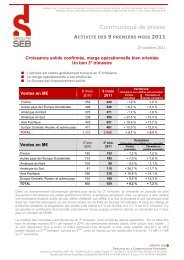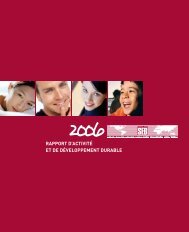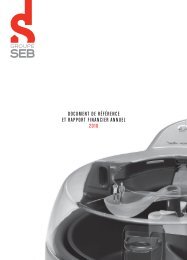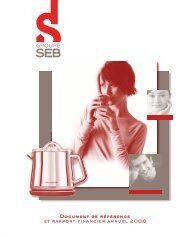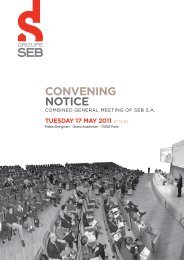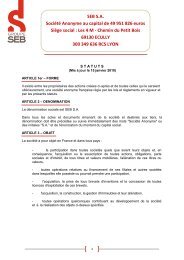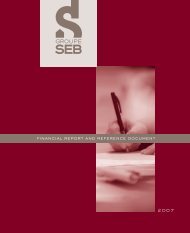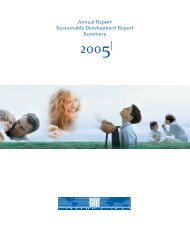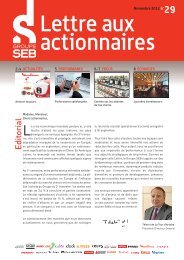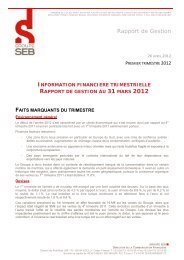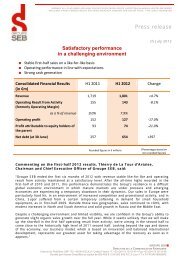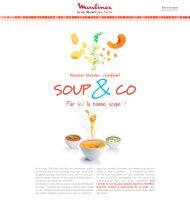financial report and registration document 2011 - Groupe SEB
financial report and registration document 2011 - Groupe SEB
financial report and registration document 2011 - Groupe SEB
You also want an ePaper? Increase the reach of your titles
YUMPU automatically turns print PDFs into web optimized ePapers that Google loves.
The assumptions used – which mainly concern impairment tests on noncurrent<br />
assets – <strong>and</strong> the sensitivity of <strong>report</strong>ed amounts to changes in these<br />
assumptions are presented in the relevant notes to these consolidated<br />
fi nancial statements, in accordance with IAS 36.<br />
Estimates may be adjusted following any change in the circumstances on<br />
which they were based or when any new information comes to light. Actual<br />
results may differ from these estimates <strong>and</strong> assumptions.<br />
The main estimates <strong>and</strong> assumptions used to prepare the consolidated<br />
fi nancial statements concern the measurement of pension <strong>and</strong> other postemployment<br />
benefi t obligations (Note 22.1), deferred taxes (Note 1.4.9),<br />
property, plant <strong>and</strong> equipment (Note 1.4.3), intangible assets (Notes 1.4.1 <strong>and</strong><br />
10), investments in associates <strong>and</strong> other investments, impairment of current<br />
assets (Notes 1.4.5 <strong>and</strong> 1.4.6), short <strong>and</strong> long-term provisions (Notes 1.4.10<br />
<strong>and</strong> 1.4.11), certain fi nancial instruments (Note 1.4.4 - Derivative instruments)<br />
<strong>and</strong> share-based payments (Note 1.4.10).<br />
Note 1.4. ACCOUNTING POLICIES<br />
AND VALUATION METHODS<br />
The fi nancial statements of Group companies are prepared in accordance<br />
with local generally accepted accounting principles. They are restated where<br />
necessary to comply with Group accounting policies.<br />
The notes to the consolidated fi nancial statements include analyses of assets<br />
<strong>and</strong> liabilities by maturity where disclosure of this information is required<br />
under IFRS.<br />
The methods used to measure intangible assets, property, plant <strong>and</strong><br />
equipment, inventories <strong>and</strong> trade receivables are described below.<br />
1.4.1. Intangible assets<br />
A) DEVELOPMENT COSTS<br />
Under IAS 38 – Intangible Assets, research costs are recognised as an<br />
expense <strong>and</strong> development costs are recognised as an intangible asset when<br />
the Group can demonstrate (IAS 38, paragraph 57):<br />
� its intention to complete the development project;<br />
� that it is probable that the expected future economic benefi ts attributable<br />
to the asset will fl ow to the Group;<br />
� its ability to reliably measure the cost of the asset.<br />
Development costs that do not fulfi l the above criteria are expensed as<br />
incurred.<br />
In the consolidated fi nancial statements, qualifying development costs<br />
incurred after the advance design phase <strong>and</strong> before the manufacturing phase<br />
are recognised as intangible assets.<br />
Development costs are amortised on a straight-line basis over three to<br />
fi ve years, corresponding to the same useful life as that applied to specifi c<br />
tooling.<br />
Financial Report <strong>and</strong> Registration Document <strong>2011</strong><br />
5<br />
Consolidated fi nancial statements<br />
Notes to the consolidated fi nancial statements<br />
B) OTHER INTANGIBLE ASSETS<br />
Software licences <strong>and</strong> internal software development costs are recognised as<br />
intangible assets when it is probable that they will generate future economic<br />
benefi ts. They are amortised by the straight-line method over periods ranging<br />
from three to fi ve years. Other software licences <strong>and</strong> software development<br />
costs are expensed as incurred.<br />
Patents, licences <strong>and</strong> trademarks with a fi nite useful life are amortised over<br />
the shorter of the period of legal protection <strong>and</strong> their expected useful life,<br />
not to exceed fi fteen years.<br />
Trademarks with an indefi nite useful life are not amortised but are tested<br />
for impairment.<br />
C) GOODWILL<br />
Goodwill, corresponding to the excess of the Group’s interest in the net<br />
fair value of the identifi able assets <strong>and</strong> liabilities acquired in a business<br />
combination over the consideration transferred, is recognised in the<br />
balance sheet as an asset under “Goodwill”. The consideration transferred<br />
is measured as the fair value of assets transferred, equity instruments<br />
issued <strong>and</strong> liabilities incurred by the acquirer to the former owner on the<br />
acquisition date, plus any contingent consideration. In the case of a business<br />
combination achieved in stages, the difference between the carrying amount<br />
of the previously held interest <strong>and</strong> its acquisition-date fair value is recognised<br />
directly in the income statement on the acquisition date under “Other<br />
operating income <strong>and</strong> expense”.<br />
For each business combination, any non-controlling interest in the acquiree<br />
may be measured either at fair value on the acquisition date (full goodwill<br />
method) or at the non-controlling interest’s proportionate share of the<br />
acquiree’s identifi able net assets (partial goodwill method).<br />
The fair values provisionally attributed to identifi able assets <strong>and</strong> liabilities,<br />
non-controlling interests measured at fair value <strong>and</strong> the various components<br />
of the consideration transferred may be adjusted for a period of twelve<br />
months after the acquisition date. After that period, any adjustments are<br />
recognised prospectively in profi t or loss with no adjustment to goodwill.<br />
Goodwill is not amortised but is tested for impairment at least once a<br />
year. For impairment testing purposes, goodwill is allocated to a Cash-<br />
Generating Unit (CGU), defi ned as the smallest identifi able group of assets<br />
that generates cash infl ows that are largely independent of the cash infl ows<br />
from other assets or groups of assets.<br />
The method used to test CGUs for impairment is described in Note 1.4.3.<br />
When a CGU is found to be impaired, an impairment loss corresponding<br />
to the difference between the carrying amount of the goodwill <strong>and</strong> its<br />
recoverable amount is recognised as other operating expense. Impairment<br />
losses on goodwill are not reversible.<br />
Negative goodwill is recognised directly in the income statement under<br />
“Other operating income <strong>and</strong> expense” <strong>and</strong> is attributed in full to the acquirer.<br />
1.4.2. Property, plant <strong>and</strong> equipment<br />
Property, plant <strong>and</strong> equipment are initially recognised at cost <strong>and</strong> are<br />
depreciated by the straight-line method over their estimated useful lives.<br />
GROUPE <strong>SEB</strong><br />
5<br />
85



